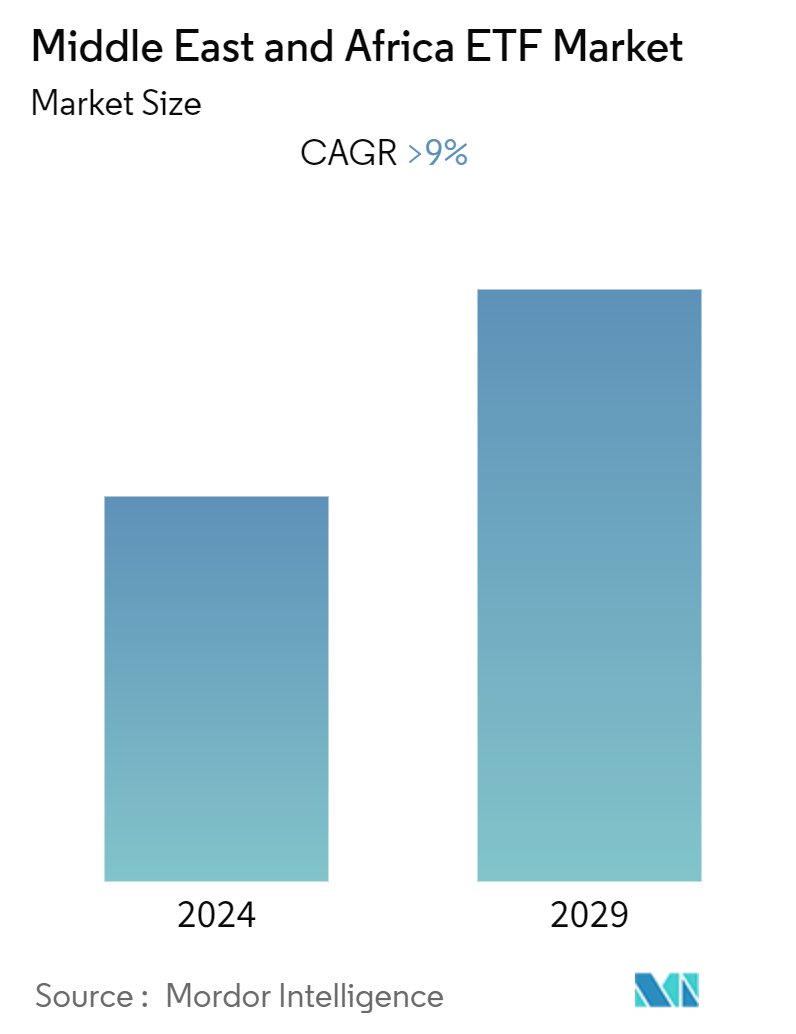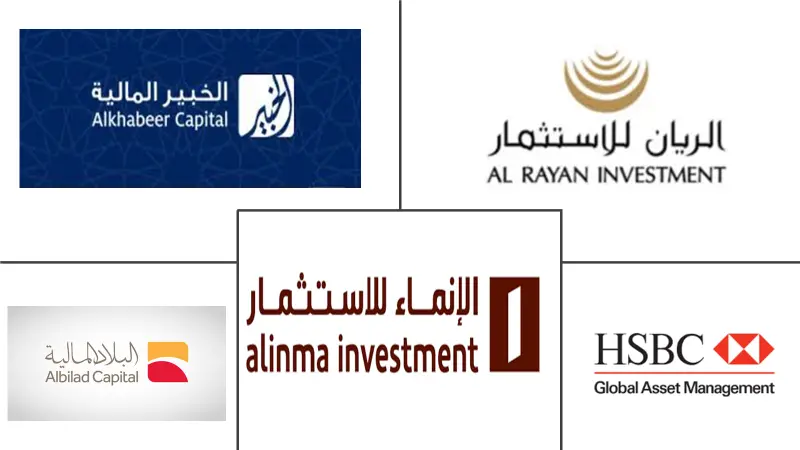Market Size of Middle East And Africa ETF Industry

| Study Period | 2020 - 2029 |
| Base Year For Estimation | 2023 |
| Forecast Data Period | 2024 - 2029 |
| Historical Data Period | 2020 - 2022 |
| CAGR (2024 - 2029) | 9.00 % |
| Market Concentration | High |
Major Players
*Disclaimer: Major Players sorted in no particular order |
Middle East And Africa ETF Market Analysis
The Middle East And Africa ETF Market is expected to register a CAGR of greater than 9% during the forecast period.
The Middle East and Africa Exchange Traded Fund (ETF) market is expected to experience significant growth throughout the forecast period. This growth is driven by various factors, including the relatively underdeveloped state of the ETF market in the region. Expansion opportunities can be found in fostering increased collaboration, receiving regulatory support, and introducing more locally listed ETFs, all of which contribute to the overall growth of the market.
Countries like Saudi Arabia and Qatar, with more developed ETF markets, present models for regional growth and can serve as catalysts for other nations. Initiatives to enhance investor education and awareness can drive greater participation in ETFs, contributing to increased trading volumes and market liquidity.
Exploring opportunities in foreign investments through ETFs domiciled outside the Middle East is a notable trend, while creating a conducive regulatory environment and developing innovative ETF products tailored to the region can enhance market appeal.
The proven resilience of ETFs during market turbulence, coupled with the leverage of digital investing trends, contributes to their attractiveness as investment instruments. As the market matures, strategic partnerships and collaborations emerge as key drivers, unlocking new avenues for growth and making the Middle East and Africa ETF market a dynamic segment of the financial landscape.
Middle East And Africa ETF Industry Segmentation
An exchange-traded fund (ETF) is a type of pooled investment that tracks a particular index, sector, commodity, or asset. They can be purchased or sold in the stock exchanges like any other regular stock.
The Middle East and Africa ETF market is segmented by management type, ETF type, and country. By management type, the market is sub-segmented into actively managed ETFs and passively managed ETFs. By ETF type, the market is sub-segmented into equity ETF, fixed income ETF, commodity ETF, currency ETF, real estate ETF, and other ETFs. By country, the market is sub-segmented into Saudi Arabia, the United Arab Emirates, Kuwait, Israel, South Africa, and others. The report offers market size and values in (USD) during the forecasted years for the above segments.
| By ETF Type | |
| Equity ETF | |
| Fixed Income ETF | |
| Commodity ETF | |
| Real Estate ETF | |
| Currency ETF | |
| Other ETFs |
| By Management Type | |
| Actively Managed ETF | |
| Passively Managed ETF |
| By Country | |
| Saudi Arabia | |
| United Arab Emirates | |
| Kuwait | |
| Israel | |
| South Africa | |
| Rest of MENA |
Middle East And Africa ETF Market Size Summary
The Middle East and Africa ETF market is poised for substantial growth, driven by the region's relatively nascent ETF landscape. This growth is supported by increased collaboration, regulatory backing, and the introduction of more locally listed ETFs. Countries like Saudi Arabia and Qatar, with their more developed ETF markets, serve as models for regional expansion. Efforts to boost investor education and awareness are expected to enhance participation, thereby increasing trading volumes and market liquidity. The market is also witnessing a trend towards foreign investments through ETFs domiciled outside the region, alongside the development of innovative ETF products tailored to local needs. The resilience of ETFs during market fluctuations and the rise of digital investing further enhance their appeal as investment vehicles. As the market evolves, strategic partnerships and collaborations are becoming crucial, opening new growth avenues and solidifying the Middle East and Africa ETF market's position within the global financial landscape.
Within the MEA region, a variety of equity ETFs offer investors exposure to specific stock markets, with notable options like the MSCI Middle East and Africa Index ETF and the FTSE Middle East ETF. These ETFs provide a broad view of the region's equity markets, encompassing countries such as Saudi Arabia, the UAE, Egypt, and South Africa. South Africa, in particular, stands out with its robust financial infrastructure and established regulatory environment, commanding the largest market share in the MEA ETF sector. The Johannesburg Stock Exchange serves as the primary trading platform, offering a diverse range of ETFs across various asset classes. While South Africa leads, other MEA nations like the UAE, Saudi Arabia, and Egypt are also experiencing growth in their ETF markets. The presence of both local and foreign players, including Al Bilad, Alinma Investment, and international firms like Blackrock and Invesco, underscores the competitive landscape. Recent partnerships, such as those between Abu Dhabi Securities Exchange and HSBC Bank, highlight ongoing efforts to expand digital asset offerings in the region.
Middle East And Africa ETF Market Size - Table of Contents
-
1. MARKET DYNAMICS AND INSIGHTS
-
1.1 Market Overview
-
1.2 Market Drivers
-
1.2.1 Decline in Cost of Service Providers
-
1.2.2 Availiblity of New distribution platform in the region
-
-
1.3 Market Restraints
-
1.3.1 Market Saturation (lack of Availiblity of new asset class)
-
1.3.2 Extreme market events increasing risk associate with ETF, dampening their demand.
-
-
1.4 Market Opportunities
-
1.4.1 Use of big data, digital technology by ETF firms for improving decision-making process.
-
1.4.2 Expanding global footprint and product of ETF Firms for competing outside home market.
-
-
1.5 Industry Attractiveness - Porters' Five Forces Analysis
-
1.5.1 Threat of New Entrants
-
1.5.2 Bargaining Power of Buyers
-
1.5.3 Bargaining Power of Suppliers
-
1.5.4 Threat of Substitutes
-
1.5.5 Intensity of Competitive Rivalry
-
-
1.6 Insight on Various Government Regulations in the Market
-
1.7 Impact of COVID-19 on the Market
-
-
2. MARKET SEGMENTATION
-
2.1 By ETF Type
-
2.1.1 Equity ETF
-
2.1.2 Fixed Income ETF
-
2.1.3 Commodity ETF
-
2.1.4 Real Estate ETF
-
2.1.5 Currency ETF
-
2.1.6 Other ETFs
-
-
2.2 By Management Type
-
2.2.1 Actively Managed ETF
-
2.2.2 Passively Managed ETF
-
-
2.3 By Country
-
2.3.1 Saudi Arabia
-
2.3.2 United Arab Emirates
-
2.3.3 Kuwait
-
2.3.4 Israel
-
2.3.5 South Africa
-
2.3.6 Rest of MENA
-
-
Middle East And Africa ETF Market Size FAQs
What is the current Middle East and Africa ETF Market size?
The Middle East and Africa ETF Market is projected to register a CAGR of greater than 9% during the forecast period (2024-2029)
Who are the key players in Middle East and Africa ETF Market?
Al Bilad Capital, Alinma Investment, Al Rayan Qatar, HSBC Saudi and Blackrock are the major companies operating in the Middle East and Africa ETF Market.

